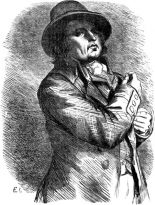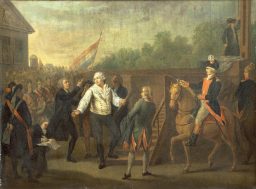
An Episode under the Terror
THE HUMAN COMEDY – Honoré de Balzac XIIth (twelfth) volume of works of Honoré de Balzac edited by widow André Houssiaux, publisher, Hebert and Co, successors, 7 rue Perronet – Paris (1877) Scenes from political life 
AN EPISODE UNDER THE TERROR WORK DEDICATED A MONSIEUR GUYONNET-MERVILLE Shouldn’t you, dear old boss, explain to those curious to know everything, where I was able to learn enough procedure to conduct the affairs of my little world, and consecrate here the memory of the kind and witty man who said to Scribe, another clerk-amateur, “Go to theStudyI can assure you there’s plenty of work to be done. by meeting him at the ball; but do you need this public testimony to be certain of the author’s affection? Un épisode sous la Terreur is a short story by Honoré de Balzac, published in 1842 in Le Livre des Salons, under the title Une messe en 1793. In 1845, the text took on its definitive title, published by Chlendowski. In the 1846 Furne edition of La Comédie humaine, it appears in the Scènes de la vie politique with a dedication to Monsieur Guyonnet-Merville, the solicitor with whom Balzac had completed his legal apprenticeship.
Analysis of the work Un épisode sous la Terreur is part of another series in La Comédie humaine, Scenes from Political Life. Les scènes de la vie politique marks the start of the divisions in La Comédie humaine that Balzac didn’t have time to complete according to his overall plan. The Comédie humaine, in fact, is divided into two sections of different character: The set of Etudes de mœurs au XIXe siècle and all the Philosophical studies. All the novels and short stories we have published so far in this edition belong to the Studies in 19th-century manners. These were divided into six series, which should have been of equal importance, Scenes from private life, the Scènes de la vie de province, and the Scènes de la vie parisienne, followed by Scènes de la vie politique, Scènes de la vie militaire and Scènes de la vie de campagne. The first three of these Scènes series each occupy four in 8° volumes of the first edition of La Comédie humaine, published under Balzac’s supervision in 1842. The last three, on the other hand, were announced and started, but never completed. Scènes de la vie politique is the first of these. Here’s how Balzac presented this series in hisIntroduction aux études de mœurs au XIXe siècle , published in 1835 by his friend Félix Davin: ” Scènes de la vie parisienne concludes the paintings of individual life. Already, in these three galleries of paintings, everyone has seen themselves again, young, old and old again. Life flourished, the soul blossomed, as the author put it, under the solar power of love, then calculations came, love became passion, force led to abuse, finally the accumulation of interests and the continual gratification of the senses, the blasement of the soul and implacable necessities in presence produced the extremes of Parisian life. Everything is said about man as man. The Scènes de la vie politique (Scenes from political life ) will express broader thoughts. The people portrayed will represent the interests of the masses, placing themselves above the laws to which the characters in the previous three series were enslaved, and who fought against them with varying degrees of success. This time, it’s no longer the interplay of private interests that the author paints for us, but the appalling movement of the social machine, and the contrasts produced by particular interests mingling with the general interest. So far, the author has shown feelings and thoughts in constant opposition to society, but in Scenes from Political LifeHe’ll show thought as an organizing force, and feeling as completely abolished. Here, then, the situations will be both comic and tragic. The characters have a people and a monarchy behind them; they symbolize in themselves the past, the future or its transitions, and struggle no longer with individuals, but with personified affections, with the resistance of the moment represented by men.” Balzac didn’t have the time to realize this magnificent program, which has so many resonances for modern readers. Only two novels, one of which is unfinished, Une ténébreuse affaire and Le Député d’Arcis, and two short stories, Un épisode sous la Terreur and Z.-P. d’Arcis, remain from this grandiose subdivision: Un épisode sous la Terreur and Z. Marcas. An episode during the Terror does not meet Balzac’s 1835 definition of Scènes de la vie politique. It’s not even news that was destined to take its place among the great divisions of The Human Comedy It’s a work of circumstance, written to order, which Balzac included with The Human Comedywhich, in terms of date and inspiration, belongs to a completely different stage of Balzac’s life, to the years when he was still an obscure, hard-working writer. This short story was written by Balzac in 1829, around the same time as Les Chouans, the first novel to bear his name. It recounts a strange “episode” in the life of Charles-Henri Sanson, the Revolutionary executor who had to put King Louis XVI to death. When it was published, it appeared without a signature, in the form of aIntroduction to Memoirs for the History of the French Revolutionby Sanson, executor of criminal arrests during the Revolution. These Sanson’s memoirspublished in two volumes in 1829, had been written by a trio of compilers including Marco Saint-Hilaire, Louis-François Lhéritier, who called himself Lhéritier de l’Ain, and Balzac, who until then had only written under various pseudonyms. Sanson, who had given written permission to use his name, received Marc Saint-Hilaire several times, to whom he apparently handed over a file, and then Balzac. Theepisode recounted in this story is probably imaginary in the form Balzac gave it, but it’s not impossible that it relates to a true fact that Balzac would have gathered from Sanson himself. Sanson’s approach is not implausible, given that he was accused of royalism by several journalists of the time, notably Camille Desmoulins, and had to defend himself by suing them. Balzac’s story, which he was right to pick up, is a lovely short story, skilfully crafted, enigmatic, touching in its subject matter, mysterious in its strange atmosphere of mist, snow and danger, in an isolated neighborhood on the outskirts of Paris, in those days almost “the zone”, during the terrible winter of 1793, so dramatic for those being hunted. An unknown man, whose identity we discover at the end, has a refractory priest say mass in the greatest secrecy for the soul of King Louis XVI, in order to save his life.

Charles-Henri Sanson
The Story In a dark alleyway (as often found in La Comédie humaine: Ferragus, Les Proscrits, L’Envers de l’histoire contemporaine), a man follows an old woman who turns out to be a nun (Sister Marthe) to fetch wafers from a pastry shop. Hosts to bring to Abbé Marolles to celebrate mass. The man (we only learn this at the end) is in fact the executioner Charles-Henri Sanson, who cut off Louis XVI’s head. A pious man despite his “function”, Sanson asks for nothing more than a mass for the soul of the deceased king. Balzac doesn’t rely on what might have been, because the Sansons, executioners from father to son, were very pious. Balzac had met Charles-Henri Sanson’s son, Henri-Nicolas-Charles Sanson, and perhaps the son’s stories had enlightened the author of La Comédie humaine on a human aspect of their horrible function. The story is admirably suspenseful. 
Genealogy of characters Abbé Marolles: Clergyman hiding Louis XVI’s executioner. Sister Marthe: Religious sister, born Beauséant. Sister Agathe: Religious sister, born in Langeais. Monsieur Ragon: Perfumer, born in 1748. Madame Ragon: her maiden name is Popinot, sister of magistrate Popinot and Anselme’s aunt.
1) Source analysis: Preface, taken from Volume XVIII, compiled from the complete text of the Comédie Humaine published by France Loisirs 1985 under the auspices of the Société des Amis d’Honoré de Balzac.
2) Source : Additional notes and story theme: Wikipedia.
3) Source: genealogy of characters: Félicien Marceau “Balzac et son monde” Gallimard.
No Comments